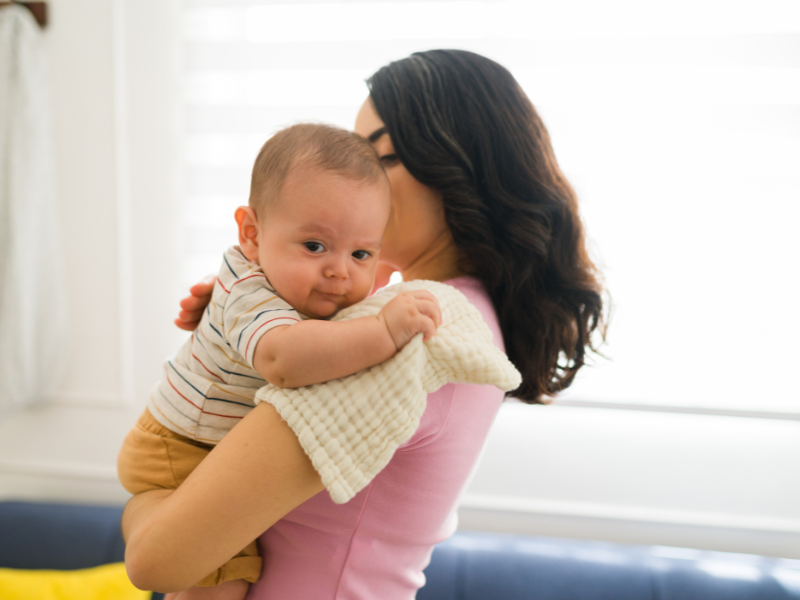Do Breastfed Babies Need to Burp?
It’s a common question I hear from new moms. The simple answer is, sometimes!
Breastfed babies often need to be burped less than bottle-fed babies. Some lucky little ones don’t seem to need burping at all. But for others, trapped gas can cause cramps and fussiness. The truth is, every baby is different. You’ll get to know what your baby needs.

Why Do Some Breastfed Babies Swallow More Air?
You might wonder why your breastfed baby seems gassy. Usually, breastfed babies swallow less air because they have more control over the milk flow.
However, some things can cause them to gulp down more air:
- A fast milk let-down: If your milk flows very quickly, your baby might gulp to keep up.
- An overabundance of milk: Having a very full supply can also make the flow fast.
- Acid reflux: Babies with reflux often feel better when burped more frequently to ease discomfort.
If you notice your baby is gulping, choking, or seems uncomfortable while nursing, they might be swallowing extra air.
Signs Your Baby Needs to Burp
How do you know it’s time to burp? Watch your baby, not the clock. If your little one seems fussy, squirms during a feed, or pulls away from the breast, they might have a bubble of air trapped.
It’s normal for babies to be gassy sometimes as their little digestive systems mature. A little crying is also totally normal and part of their development. But if they seem uncomfortable, a good burp can make a world of difference. Here are the common signs that point to blocked air:
- Fussiness or crying during or after feeding – your baby may seem uncomfortable or unsettled.
- Pulling legs up to the tummy – a classic sign of gas or digestive discomfort.
- Arching their back – they may do this when they feel pressure in the stomach.
- Clenching fists or stiffening body – often a reaction to tummy discomfort.
- Squirming or restless movements – wriggling a lot can indicate trapped air.
- Stopping feeding suddenly – they may pause or refuse to feed because of pressure.
- Bloated or firm tummy – you may notice the belly feels tight or hard.
- Passing gas frequently – a natural way for them to release trapped air.
- Spitting up more than usual – sometimes linked to trapped air causing reflux.
What If Your Baby Won’t Burp?
If you’ve tried burping and nothing happens, don’t worry! It might mean that your baby doesn’t have any air to release. If your baby seems happy and content after feeding, you don’t need to worry. If your baby still seems uncomfortable…try the different buping techniques below.
Burping Techniques
Patting your baby’s back gently puts a little pressure on their tummy, which helps push the air up and out. You can try a few different positions to see what works best for your baby.
How to Burp Baby
- Over Your Shoulder: This is the most popular way to burp a newborn. Hold your baby against your chest so their chin rests on your shoulder. Support their bottom with one hand and gently pat their back with the other. Don’t forget a burp cloth!
- Sitting on Your Lap: Sit your baby on your lap, facing away from you. Use one hand to support their chest and head by cupping their chin (be sure to keep your fingers away from their throat). Lean them forward slightly and pat their back with your other hand.
- Lying on Your Lap: Lay your baby tummy-down across your knees. Make sure their head is turned to the side and is higher than their chest. Gently rub or pat their back.

More Ways to Relieve Gas
These gentle movements can also help move trapped gas.
- Bicycle Legs: Lay your baby on their back and gently move their legs in a bicycling motion.
- Knees to Chest: Gently press your baby’s knees up toward their chest for a few seconds and then release.
- Tummy Massage: Gently massaging your baby’s tummy in a clockwise motion can help get things moving.
- Babywearing: Wearing your baby in a sling or carrier keeps them upright. The upright position and your movement can help gas escape naturally.

When to Burp Baby
You can burp baby in the middle of a feeding or after they are finished. A good time to try is when you switch breasts or when your baby takes a natural pause.
Sometimes a baby falls asleep while feeding but wakes up crying a little later. This might be from a trapped air bubble. A quick burp might be all they need to settle back to sleep.

When Can You Stop Burping a Baby?
So, at what age can you stop burping your baby? Most babies outgrow the need to be burped around 4 to 6 months old. By this age, their digestive systems are more mature, and they have better control over their bodies, so they naturally swallow less air.
Burping a Breastfed Baby at Night
Good news! You may not need to burp baby as much during night feedings. At night, babies often feed in a calmer, slower way, which means they swallow less air. If your baby seems comfortable after a nighttime feed, you can let them drift back to sleep without a full burping session.
How to Burp a Newborn Baby
Resources
Healthychildren.org – Gas relief for babies
La leche League – Reflux


